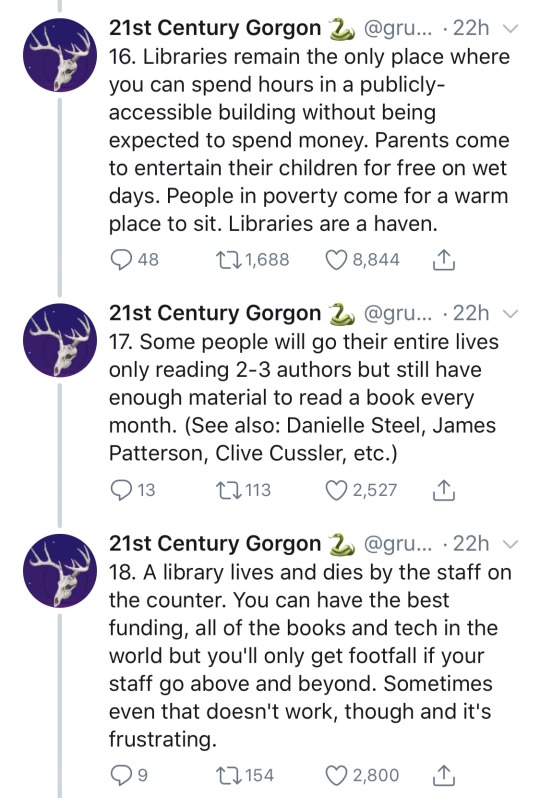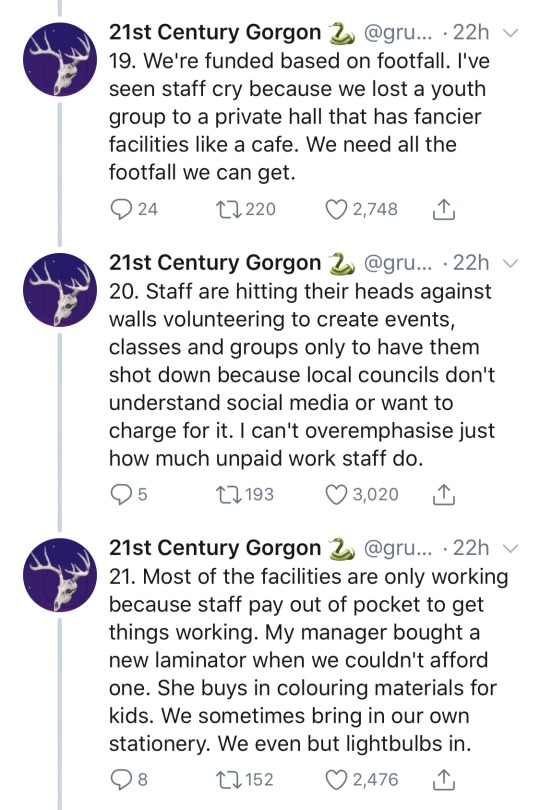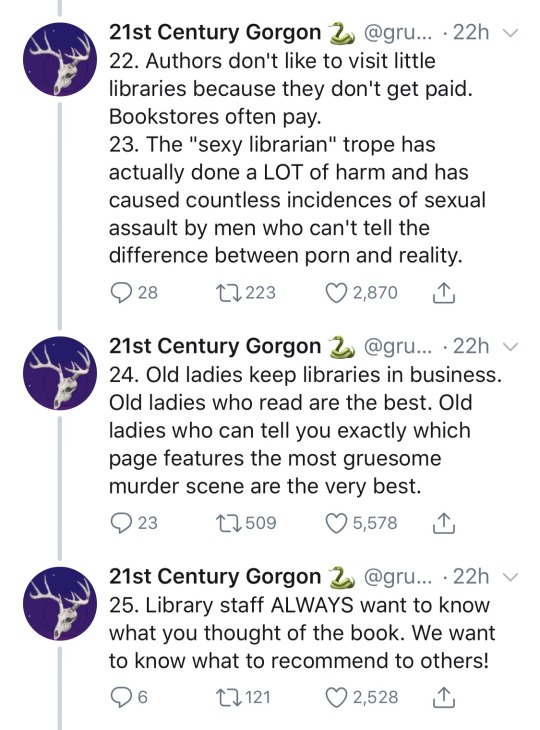Text
As a cis woman, I will continue to stand with and support my trans sisters, not just for their sake but for my own and other cis women too, and I want you all to know that. I refuse to let womanhood be reduced to a set of specific biological features or to let people be denied the right to their gender or denied equal rights because of said gender.
4 notes
·
View notes
Text
When it comes to “problematic” media, I think it’s important to acknowledge there are differences between “the creator(s) were well-intentioned and/or not intending to hurt/offend anyone, but simply didn’t think things through enough and/or were misinformed/ignorant,” “the creator(s) featured content and viewpoints in their story that they are not condoning - which they are most likely condemning - and this is evidenced by analyzing the content with media literacy and/or observing the creator(s) real life statements/actions,” and “the creator(s) are intentionally expressing and encouraging harmful and/or untrue ideas/behaviour/information through their work.” And, of course, the fourth category: the creator(s) are actively saying, causing, and doing harmful stuff, often using the money, attention, connections, and other resources they gain from the commercial success of and gains from their work.
0 notes
Text
Chousou’s death fits his character arc, the story’s themes, and the narrative, but just imagine more Yuuji and Chousou interaction, plus Chousou finding his place in the world and jujutsu society post the culling games. Imagine Esou and Kechizu living and doing the same too. Incredible AU there, I’m telling you.
3 notes
·
View notes
Text
It’s 1am in the morning and time for me to be sad about Megumi. And a bunch of the other JJK characters who suffered great unfairness, tragedy, and loss. 😢
4 notes
·
View notes
Text
One of my favourite things about Phantom Parade is Yuuji constantly standing there with this look on his face like “no thoughts, just happy to be here” while Megumi looks like he is slowly dying inside and wishes he stayed home, preferably in bed.


43 notes
·
View notes
Text
Sukuna’s twin being Wasuke fits better thematically but his twin being Jin is just so much funnier XD
27 notes
·
View notes
Text

Whipped up this little doodle while I was bored
13 notes
·
View notes
Text
Fascism
Feels like a particularly pertinent time to bring up fascism. Fascism doesn’t have a single clear or universal definition, and what exactly defines fascism is a highly disputed subject even among historians, political scientists, and other scholars and experts in relevant fields. There are multiple definitions and characteristics of fascism depending on where you look - though I will stress that some sources are most definitely more reliable and genuine than others. Some example definitions include:
“A political ideology and mass movement that dominated many parts of central, southern, and eastern Europe between 1919 and 1945 and that also had adherents in western Europe, the United States, South Africa, Japan, Latin America, and the Middle East… fascist parties and movements differed significantly from one another, they had many characteristics in common, including extreme militaristic nationalism, contempt for electoral democracy and political and cultural liberalism, a belief in natural social hierarchy and the rule of elites, and the desire to create a Volksgemeinschaft (German: "people's community"), in which individual interests would be subordinated to the good of the nation."
From Encyclopaedia Britannica https://www.britannica.com/topic/fascism
“A populist political philosophy, movement, or regime (such as that of the Fascisti) that exalts nation and often race above the individual, that is associated with a centralized autocratic government headed by a dictatorial leader, and that is characterized by severe economic and social regimentation and by forcible suppression of opposition.”
From Merriam-Webster Dictionary https://www.merriam-webster.com/dictionary/fascism
“The Moral Order hierarchy is commonly extended in [Anglo-American] culture to include other relations of moral superiority: Western culture over non-Western culture; America over other countries; citizens over immigrants; Christians over non-Christians; straights over gays; the rich over the poor. Incidentally, the Moral Order metaphor gives us a better understanding of what fascism is: Fascism legitimizes such a moral order and seeks to enforce it through the power of the state.”
From Philosophy in the Flesh: The Embodied Mind and its Challenge to Western Thought by George Lakoff and Mark Johnson
“Fascism is not mere oppression. It is a more holistic ideology that elevates the state over the individual (except for a sole leader, around whom there is a cult of personality), glorifies hypernationalism and racism, worships military power, hates liberal democracy, and wallows in nostalgia and historical grievances. It asserts that all public activity should serve the regime, and that all power must be gathered in the fist of the leader and exercised only by his party.”
From “Trump Crosses a Crucial Line” by Tom Nicholas https://www.theatlantic.com/newsletters/archive/2023/11/trump-crosses-a-crucial-line/676031/
“Fascism is a set of ideologies and practices that seeks to place the nation, defined in exclusive biological, cultural, and/or historical terms, above all other sources of loyalty, and to create a mobilized national community. Fascist nationalism is reactionary in that it entails implacable hostility to socialism and feminism, for they are seen as prioritizing class or gender rather than nation. This is why fascism is a movement of the extreme right. Fascism is also a movement of the radical right because the defeat of socialism and feminism and the creation of the mobilized nation are held to depend upon the advent to power of a new elite acting in the name of the people, headed by a charismatic leader, and embodied in a mass, militarized party. Fascists are pushed towards conservatism by common hatred of socialism and feminism, but are prepared to override conservative interests – family, property, religion, the universities, the civil service – where the interests of the nation are considered to require it. Fascist radicalism also derives from a desire to assuage discontent by accepting specific demands of the labour and women's movements, so long as these demands accord with the national priority. Fascists seek to ensure the harmonization of workers' and women's interests with those of the nation by mobilizing them within special sections of the party and/or within a corporate system. Access to these organizations and to the benefits they confer upon members depends on the individual's national, political, and/or racial characteristics. All aspects of fascist policy are suffused with ultranationalism.”
From Fascism: A Very Short Introduction by Kevin Passmore
“A form of political behavior marked by obsessive preoccupation with community decline, humiliation or victimhood and by compensatory cults of unity, energy and purity, in which a mass-based party of committed nationalist militants, working in uneasy but effective collaboration with traditional elites, abandons democratic liberties and pursues with redemptive violence and without ethical or legal restraints goals of internal cleansing and external expansion.”
From The Anatomy of Fascism by Robert Paxton
“A cult of the leader who promises national restoration in the face of humiliation brought on by supposed communists, Marxists and minorities and immigrants who are supposedly posing a threat to the character and the history of a nation" and further observed that "The leader proposes that only he can solve it and all of his political opponents are enemies or traitors.”
From Jason Stanley https://www.npr.org/2020/09/06/910320018/fascism-scholar-says-u-s-is-losing-its-democratic-status
You’ll notice some reoccurring themes and characteristics, something you’ll also see in different lists of the characteristics of fascism, including:
1. The first feature of Ur-Fascism is the cult of tradition. Traditionalism is of course much older than fascism. Not only was it typical of counter-revolutionary Catholic thought after the French revolution, but it was born in the late Hellenistic era, as a reaction to classical Greek rationalism. In the Mediterranean basin, people of different religions (most of them indulgently accepted by the Roman Pantheon) started dreaming of a revelation received at the dawn of human history. This revelation, according to the traditionalist mystique, had remained for a long time concealed under the veil of forgotten languages — in Egyptian hieroglyphs, in the Celtic runes, in the scrolls of the little known religions of Asia.
This new culture had to be syncretistic. Syncretism is not only, as the dictionary says, “the combination of different forms of belief or practice”; such a combination must tolerate contradictions. Each of the original messages contains a silver of wisdom, and whenever they seem to say different or incompatible things it is only because all are alluding, allegorically, to the same primeval truth.
As a consequence, there can be no advancement of learning. Truth has been already spelled out once and for all, and we can only keep interpreting its obscure message.
One has only to look at the syllabus of every fascist movement to find the major traditionalist thinkers. The Nazi gnosis was nourished by traditionalist, syncretistic, occult elements. The most influential theoretical source of the theories of the new Italian right, Julius Evola, merged the Holy Grail with The Protocols of the Elders of Zion, alchemy with the Holy Roman and Germanic Empire. The very fact that the Italian right, in order to show its open-mindedness, recently broadened its syllabus to include works by De Maistre, Guenon, and Gramsci, is a blatant proof of syncretism.
If you browse in the shelves that, in American bookstores, are labeled as New Age, you can find there even Saint Augustine who, as far as I know, was not a fascist. But combining Saint Augustine and Stonehenge — that is a symptom of Ur-Fascism.
2. Traditionalism implies the rejection of modernism. Both Fascists and Nazis worshiped technology, while traditionalist thinkers usually reject it as a negation of traditional spiritual values. However, even though Nazism was proud of its industrial achievements, its praise of modernism was only the surface of an ideology based upon Blood and Earth (Blut und Boden). The rejection of the modern world was disguised as a rebuttal of the capitalistic way of life, but it mainly concerned the rejection of the Spirit of 1789 (and of 1776, of course). The Enlightenment, the Age of Reason, is seen as the beginning of modern depravity. In this sense Ur-Fascism can be defined as irrationalism.
3. Irrationalism also depends on the cult of action for action’s sake. Action being beautiful in itself, it must be taken before, or without, any previous reflection. Thinking is a form of emasculation. Therefore culture is suspect insofar as it is identified with critical attitudes. Distrust of the intellectual world has always been a symptom of Ur-Fascism, from Goering’s alleged statement (“When I hear talk of culture I reach for my gun”) to the frequent use of such expressions as “degenerate intellectuals,” “eggheads,” “effete snobs,” “universities are a nest of reds.” The official Fascist intellectuals were mainly engaged in attacking modern culture and the liberal intelligentsia for having betrayed traditional values.
4. No syncretistic faith can withstand analytical criticism. The critical spirit makes distinctions, and to distinguish is a sign of modernism. In modern culture the scientific community praises disagreement as a way to improve knowledge. For Ur-Fascism, disagreement is treason.
5. Besides, disagreement is a sign of diversity. Ur-Fascism grows up and seeks for consensus by exploiting and exacerbating the natural fear of difference. The first appeal of a fascist or prematurely fascist movement is an appeal against the intruders. Thus Ur-Fascism is racist by definition.
6. Ur-Fascism derives from individual or social frustration. That is why one of the most typical features of the historical fascism was the appeal to a frustrated middle class, a class suffering from an economic crisis or feelings of political humiliation, and frightened by the pressure of lower social groups. In our time, when the old “proletarians” are becoming petty bourgeois (and the lumpen are largely excluded from the political scene), the fascism of tomorrow will find its audience in this new majority.
7. To people who feel deprived of a clear social identity, Ur-Fascism says that their only privilege is the most common one, to be born in the same country. This is the origin of nationalism. Besides, the only ones who can provide an identity to the nation are its enemies. Thus at the root of the Ur-Fascist psychology there is the obsession with a plot, possibly an international one. The followers must feel besieged. The easiest way to solve the plot is the appeal to xenophobia. But the plot must also come from the inside: Jews are usually the best target because they have the advantage of being at the same time inside and outside. In the U.S., a prominent instance of the plot obsession is to be found in Pat Robertson’s The New World Order, but, as we have recently seen, there are many others.
8. The followers must feel humiliated by the ostentatious wealth and force of their enemies. When I was a boy I was taught to think of Englishmen as the five-meal people. They ate more frequently than the poor but sober Italians. Jews are rich and help each other through a secret web of mutual assistance. However, the followers must be convinced that they can overwhelm the enemies. Thus, by a continuous shifting of rhetorical focus, the enemies are at the same time too strong and too weak. Fascist governments are condemned to lose wars because they are constitutionally incapable of objectively evaluating the force of the enemy.
9. For Ur-Fascism there is no struggle for life but, rather, life is lived for struggle. Thus pacifism is trafficking with the enemy. It is bad because life is permanent warfare. This, however, brings about an Armageddon complex. Since enemies have to be defeated, there must be a final battle, after which the movement will have control of the world. But such a “final solution” implies a further era of peace, a Golden Age, which contradicts the principle of permanent war. No fascist leader has ever succeeded in solving this predicament.
10. Elitism is a typical aspect of any reactionary ideology, insofar as it is fundamentally aristocratic, and aristocratic and militaristic elitism cruelly implies contempt for the weak. Ur-Fascism can only advocate a popular elitism. Every citizen belongs to the best people of the world, the members of the party are the best among the citizens, every citizen can (or ought to) become a member of the party. But there cannot be patricians without plebeians. In fact, the Leader, knowing that his power was not delegated to him democratically but was conquered by force, also knows that his force is based upon the weakness of the masses; they are so weak as to need and deserve a ruler. Since the group is hierarchically organized (according to a military model), every subordinate leader despises his own underlings, and each of them despises his inferiors. This reinforces the sense of mass elitism.
11. In such a perspective everybody is educated to become a hero. In every mythology the hero is an exceptional being, but in Ur-Fascist ideology, heroism is the norm. This cult of heroism is strictly linked with the cult of death. It is not by chance that a motto of the Falangists was Viva la Muerte (in English it should be translated as “Long Live Death!”). In non-fascist societies, the lay public is told that death is unpleasant but must be faced with dignity; believers are told that it is the painful way to reach a supernatural happiness. By contrast, the Ur-Fascist hero craves heroic death, advertised as the best reward for a heroic life. The Ur-Fascist hero is impatient to die. In his impatience, he more frequently sends other people to death.
12. Since both permanent war and heroism are difficult games to play, the Ur-Fascist transfers his will to power to sexual matters. This is the origin of machismo (which implies both disdain for women and intolerance and condemnation of nonstandard sexual habits, from chastity to homosexuality). Since even sex is a difficult game to play, the Ur-Fascist hero tends to play with weapons — doing so becomes an ersatz phallic exercise.
13. Ur-Fascism is based upon a selective populism, a qualitative populism, one might say. In a democracy, the citizens have individual rights, but the citizens in their entirety have a political impact only from a quantitative point of view — one follows the decisions of the majority. For Ur-Fascism, however, individuals as individuals have no rights, and the People is conceived as a quality, a monolithic entity expressing the Common Will. Since no large quantity of human beings can have a common will, the Leader pretends to be their interpreter. Having lost their power of delegation, citizens do not act; they are only called on to play the role of the People. Thus the People is only a theatrical fiction. To have a good instance of qualitative populism we no longer need the Piazza Venezia in Rome or the Nuremberg Stadium. There is in our future a TV or Internet populism, in which the emotional response of a selected group of citizens can be presented and accepted as the Voice of the People.
Because of its qualitative populism Ur-Fascism must be against “rotten” parliamentary governments. One of the first sentences uttered by Mussolini in the Italian parliament was “I could have transformed this deaf and gloomy place into a bivouac for my maniples” — “maniples” being a subdivision of the traditional Roman legion. As a matter of fact, he immediately found better housing for his maniples, but a little later he liquidated the parliament. Wherever a politician casts doubt on the legitimacy of a parliament because it no longer represents the Voice of the People, we can smell Ur-Fascism.
14. Ur-Fascism speaks Newspeak. Newspeak was invented by Orwell, in 1984, as the official language of Ingsoc, English Socialism. But elements of Ur-Fascism are common to different forms of dictatorship. All the Nazi or Fascist schoolbooks made use of an impoverished vocabulary, and an elementary syntax, in order to limit the instruments for complex and critical reasoning. But we must be ready to identify other kinds of Newspeak, even if they take the apparently innocent form of a popular talk show.
From “Ur-Fascism” by Umberto Eco https://theanarchistlibrary.org/library/umberto-eco-ur-fascism
1. a mass movement with multiclass membership in which prevail, among the leaders and the militants, the middle sectors, in large part new to political activity, organized as a party militia, that bases its identity not on social hierarchy or class origin but on a sense of comradeship, believes itself invested with a mission of national regeneration, considers itself in a state of war against political adversaries and aims at conquering a monopoly of political power by using terror, parliamentary politics, and deals with leading groups, to create a new regime that destroys parliamentary democracy;
2. an "anti-ideological" and pragmatic ideology that proclaims itself antimaterialist, anti-individualist, anti-liberal, antidemocratic, anti-Marxist, populist and anticapitalist, and expresses itself aesthetically more than theoretically by means of a new political style and by myths, rites, and symbols as a lay religion designed to acculturate, socialize, and integrate the faith of the masses with the goal of creating a "new man";
3. a culture founded on mystical thought and the tragic and activist sense of life conceived of as the manifestation of the will to power, on the myth of youth as artificer of history, and on the exaltation of the militarization of politics as the model of life and collective activity;
4. a totalitarian conception of the primacy of politics, conceived of as an integrating experience to carry out the fusion of the individual and the masses in the organic and mystical unity of the nation as an ethnic and moral community, adopting measures of discrimination and persecution against those considered to be outside this community either as enemies of the regime or members of races considered to be inferior or otherwise dangerous for the integrity of the nation;
5. a civil ethic founded on total dedication to the national community, on discipline, virility, comradeship, and the warrior spirit;
6. a single state party that has the task of providing for the armed defense of the regime, selecting its directing cadres, and organizing the masses within the state in a process of permanent mobilization of emotion and faith;
7. a police apparatus that prevents, controls, and represses dissidence and opposition, including through the use of organized terror;
8. a political system organized by hierarchy of functions named from the top and crowned by the figure of the "leader", invested with a sacred charisma, who commands, directs, and coordinates the activities of the party and the regime;
9. corporative organization of the economy that suppresses trade union liberty, broadens the sphere of state intervention, and seeks to achieve, by principles of technocracy and solidarity, the collaboration of the "productive sectors" under control of the regime, to achieve its goals of power, yet preserving private property and class divisions;
10. a foreign policy inspired by the myth of national power and greatness, with the goal of imperialist expansion.
From A History of Fascism, 1914–1945 by Emilio Gentile
* a sense of overwhelming crisis beyond the reach of any traditional solutions;
* the primacy of the group, toward which one has duties superior to every right, whether individual or universal, and the subordination of the individual to it;
* the belief that one’s group is a victim, a sentiment that justifies any action, without legal or moral limits, against its enemies, both internal and external;
* dread of the group’s decline under the corrosive effects of individualistic liberalism, class conflict, and alien influences;
* the need for closer integration of a purer community, by consent if possible, or by exclusionary violence if necessary;
* the need for authority by natural chiefs (always male), culminating in a national chieftain who alone is capable of incarnating the group’s historical destiny;
* the superiority of the leader’s instincts over abstract and universal reason;
* the beauty of violence and the efficacy of will, when they are devoted to the group’s success;
* the right of the chosen people to dominate others without restraint from any kind of human or divine law, right being decided by the sole criterion of the group’s prowess within a Darwinian struggle.
From The Anatomy of Fascism by Robert Paxton
1. The mythical past—used to invoke a nostalgia for a fictional time when the nation was great as it was not yet sullied by the “Other.”
2. Propaganda—to attack enemies, to justify violence, to justify laws against “Them” and to support the authoritarian leader.
3. Anti-intellectualism—to attack the media, universities, and scientists when they contradict the strong man’s authority.
4. Unreality—supporting conspiracy theories that tarnish the “Other” along with an outright denial of facts when convenient.
5. Hierarchy—espousing a “natural order” where the “Us” are hardworking, moral, law-abiding and productive members of society, while the “Other” is not.
6. Victimhood—casting “Us” as victims of “Them”, who are taking resources from “Us” and demanding special rights.
7. Law and order—using laws to justify violence, oppression, and expulsion of the “Other”.
8. Sexual anxiety—as the “Other” embraces non-traditional approaches to sexuality,
9. Appeals to the heartland—as rural communities are often more homogeneous and conservative (more “Us”) while urban cities are often more diverse, cosmopolitan (more “Them”).
10. Dismantling of public welfare and unity—by casting aside safety net programs as unfair giveaways to “Them”, who are not working, as opposed to “Us”, who are.
From How Fascism Works: The Politics of Us and Them by Jason Stanley
So, what is fascism? Using the sources above, I’m going to lay out my own little definition and summary.
Fascism is an authoritarian and ultranationalist political ideology and movement characterized by a dictatorial leader and centralized autocracy using militarism and forcible suppression of opposition for the supposed good of the nation - or rather the groups deemed deserving among the nation’s established and strictly enforced social hierarchy - often against purported enemies designated as “other” whose existences are inherently negative in some way or form and must be forcefully and - eventually inevitably - violently opposed and eliminated.
Some prominent fascist characteristics and features include:
- The belief in natural superiority and inferiority of different groups used to justify persecution
- Disdain for and violation of human rights
- Pro violence and sexism
- The idea that there is an abhorrent enemy who will bring about the downfall of society if not forcibly and/or violently defeated and/or eliminated
- The belief that the dictator represents the will of the people and is infallible
- The idea that the nation is facing a crisis which can only be fixed with fascist revolution
- Myths and ideas of an ideal past and/or traditional way of life that the country must return to
- Rejection of science and facts when incompatible with the fascist narrative
- Anti intellectualism and controlling media and education to enforce propaganda
- Forcible suppression of criticism or any non-aligning movements or parties
And yes, I do believe Trump qualifies as a fascist. He doesn’t seem to have any real or firmly held beliefs or aspirations other than self-interest, but he happily uses fascists ideas and methods to fulfil that. And as he is currently president of the United States, he is a very prominent fascist in his words and actions irregardless of his personal convictions (which I should point out is the case for all fascists - fascism is identified by objective words and actions, not internal feelings or beliefs).
1 note
·
View note
Text
Honestly Noritoshi is such a sweetie at heart and I’m so glad he got the family he deserves in the end ❤️
3 notes
·
View notes
Text

Was blessed by the RNG gods today
3 notes
·
View notes
Photo
Most of these things ring true at the regional library branch I work at in Canada. Libraries are amazing, librarians are amazing, and you should definitely visit you local library and see everything they have to offer! Nowadays most if not all community libraries also have a website with tons of information and e-resources, so you can even use the library without ever having to leave your house (provided you have internet)!









#librarylove#libraries#support local libraries#public libraries#local library#libraries rock#i love libraries#real stuff
308K notes
·
View notes
Text
I’ve fallen into Mouthwashing hell: you probably know the feeling 😭
13 notes
·
View notes
Text
Something truly scary this Halloween…

7 notes
·
View notes
Text
Orpheus’ imagination is so powerful that his hallucination is a playable character lol
7 notes
·
View notes
Text
How big do ya’ll think the overlap on the venn diagram is between people who deliberately continue to misgender trans people and/or any other gender non-conforming individuals (cis, trans, nb, whatever), and people who whinge about others using terms like “people who menstruate” (not even directed at them but just in general)?
3 notes
·
View notes
Text
Your Daily Reminder to Click for Palestine!
And if you can spare a dollar, donate to ANERA!
#support palestine#freepalastine🇵🇸#stop israel#stop arming israel#stop genocide#help how you can#humanitarian aid#palestine israel conflict
881 notes
·
View notes
Text
Japanese Buddhist Hand Seals
So have y’all seen this post?
I did some rough translations for the hand seals’ corresponding Japanese deities shown on the source website, featuring romanization of the Japanese kanji alongside the Sanskrit romanization for their Buddhist/Hindu counterparts and a brief descriptor based on what I found using the internet.

印 / Shirushi / Mudra
1 釈迦如来 / Shaka Nyorai / Shakyamuni / Historical Buddha and founder of Buddhism
2 薬師如来 / Yakushi Nyorai / Bhaisajyaguru / Medicine Buddha
3 阿弥陀如来 / Amida Nyorai / Amitābha / Buddha of Limitless Light
4 弥勒如来(弥勒菩薩) / Miroku Nyorai (Miroku Bosatsu) / Maitreya / Future Buddha
5 大日如来 / Dainichi Nyorai / Mahāvairocana / Cosmic Buddha
6 仏眼仏母 / Butsu Genbutsu Mo / Buddhalocanā / Buddha Eye Buddha
7 観世音菩薩 / Kanzeon Bosatsu / Avalokiteśvara / Bodhisattva of Compassion
8 十一面観音 / Juuichimen Kannon / Ekādaśamukha / Eleven-Faced Kannon
9 千手観音 / Senju Kannon / Avalokiteshvara / Thousand-Armed Kannon
10 不空羂索観音 / Fukuukenjaku Kannon / Amoghapasa / Unfailing Lasso Kannon
11 如意輪観音 / Nyoirin Kannon / Cintāmaṇi Cakra / Wishing Gem Wheel Kannon
12 馬頭観音 / Batou Kannon / Hayagriva / Horse Head Kannon
13 准胝観音 / Jundei Kannon / Cundī / Female Buddhist Deity
14 文殊菩薩 / Monju Bosatsu / Manjushri / Bodhisattva of Transcendent Wisdom
15 普賢菩薩 / Fugen Bosatsu / Samantabhadra / Bodhisattva of Practice
16 勢至菩薩 / Seishi Bosatsu / Mahāsthāmaprāpta / Bodhisattva of Wisdom
17 日光菩薩 / Nikkou Bosatsu / Sūryaprabha / Bodhisattva of Sunshine and Good Health
18 月光菩薩 / Gakkoi Bosatsu / Candraprabha / Bodhisattva of Moonlight
19 虚空蔵菩薩 / Kokuuzou Bosatsu / Ākāśagarbha / Bodhisattva of Space
20 地蔵菩薩 / Jizou Bosatsu / Kṣitigarbha / Bodhisattva of Children, Travellers, and the Deceased
21 金剛サッタ/ Kongousatta / Vajrasattva / Vajra Bodhisattva
22 般若菩薩 / Hannya Bosatsu / Prajñāpāramitā Devī / Bodhisattva of Inconceivable Wisdom
23 薬王菩薩 / Yakuou Bosatsu / Bhaiṣajyarāja / Bodhisattva of Medicine
24 軍荼利明王 / Gundari Myouou / Kundali / Wisdom King and Dharmapala
25 大威徳明王 / Daiitoku Myouou / Yamāntaka / Wisdom King and Destroyer of Death
26 金剛夜叉明王 / Kongouyasha Myouou / Vajrayaksa / Wrathful Wisdom King and Manifestation of Kannon/Amoghasiddhi
27 烏枢沙摩明王 / Ususama Myouou / Ucchusma / Wrathful Wisdom King and Remover of Impurities
28 愛染明王 / Aizen Myouou / Rāgarāja / Wisdom King who Transforms Lust into Spiritual Awakening
29 不動明王 / Fudou Myouou / Acala / Vanquisher of Evil and Protector of the State
30 降三世明王 / Gouzanze Myouou / Trailokyavijaya / King of Knowledge and Conqueror of the Three Worlds
31 大元帥明王 / Daigensui Myouou / Āṭavaka / Yaksha Wisdom King
32 孔雀明王 / Kujaku Myouou / Mahamayuri / Protective Goddess and Wisdom King
33 六字明王 idk how best to read this one tbh, but the English translation is: Wisdom King of the Six Characters, referencing the Six-Words-Great-Enlightening-Dharani (chant), which is associated with Avalokiteśvara / Oṃ maṇi padme hūm̐ (praise to the jewel in the lotus)
34 毘沙門天 / Bishamonten / Vaiśravaṇa / Heavenly King and God of Warriors
35 吉祥天 / Kisshouten / Śrī Mahādevī (Lakshmi) / Goddess of Beauty, Fertility, and Good Fortune
36 梵天 / Bonten / Brahma / God of Creation
37 帝釈天 / Taishakuten / Śakra / Ruler of the Trāyastriṃśa Heaven
38 弁才天 / Benzaiten / Saraswati / Goddess of the Arts
39 大黒天 / Daikokuten / Mahākāla / God of Household Wealth and Fortune
40 深沙大将 / Jinja Taishou / Shensha Shen / Protective Desert Entity originating from Chinese lore and associated with Bishamonten/Vaiśravaṇa
41 歓喜天 / Kangiten / Nandikeshvara / Sacred Bull Mount and Guardian God to Shiva
42 荼吉尼天 / Dakiniten / Dākinī / Dakini (flesh-eating spirit) Goddess associate with Inari
43 伎芸天 / Gigeiten / Celestial Maiden and Patron of the Arts said to be born from Daijizaiten/Mahesvara
44 摩利支天 / Marishiten / Mārīcī / Goddess of Light, Dawn, and Patron of Warriors
45 韋駄天 / Idaten / Skanda / Messenger and Protector of Buddhist Shrines/Teachings
46 鬼子母神 / Kishimojin / Hārītī / Wrathful and Protective Goddess of Children
47 閻魔天 / Enmaten / Yama / God of Death and Justice
48 大日如来法界定 / Dainichi Nyorai Houkai / Mahāvairocana/Vairocana Dharmadhatu / Cosmic Buddha Realm
8 notes
·
View notes